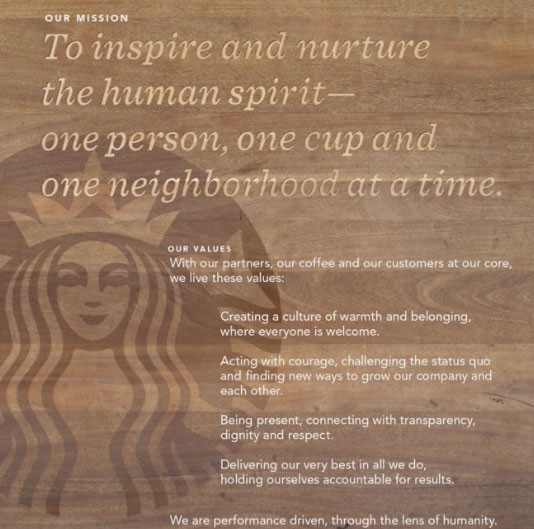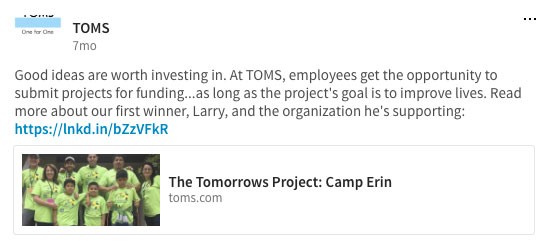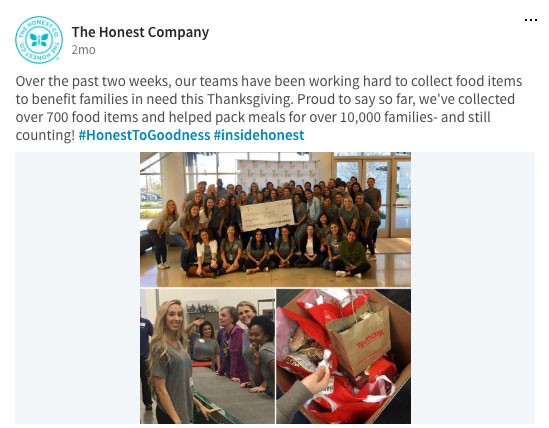How Starbucks, Honest Co., and TOMS Have Made Purpose a Vital Part of Their Culture (and You Can Too)
If you think “purpose at work” (the feeling that your work matters to you, your company and the world) is a nice-to-have but not really a must for success, think again. It turns out “purpose” has a big impact on your company's bottom line.
According to recent research from the EY Beacon Institute and Harvard Business Review, purpose-driven companies saw 85% growth in their revenue over the past three years. In the same period, 42% of companies that can’t articulate their do good mission, showed a drop in revenue.
And when you think about it, it makes sense. According to our research, companies that have a purpose-driven culture have employees who are more likely to be fulfilled and satisfied at work, form strong relationships with their coworkers, are higher performers, and speak highly of their company. Purpose is a competitive edge - one that makes your company more successful.
The question is, how do you create a mission driven culture and recruit for purpose? At Talent Connect 2016, we sat down with Anat Mahrer, VP of HR and Talent Management at TOMS, Leigha May, Senior Manager of Recruitment at The Honest Company, and John Phillips, SVP of Global Talent Aquisition & Partner (Employee) Enablement at Starbucks. Each of them have their own approaches to creating a culture of purpose at their companies. And, they want you to try out what they are doing because it will make the world a better place.
Here are four tips you can use to bring purpose to life at your organization:
1. Screen for candidates who are purpose-driven and will bring that into your company
The focus on culture and team impact are important whether you are at a company big or small. Honest Co. has been in hyper growth over the past 4 years, tripling their staff over the past 2 years to almost 600 people. Leigha May knows that their recruitment team has been the gatekeepers and builders of their strong culture of giving.
“Our team can singlehandedly change the culture of our company if we’re not hiring in the right way. With every hire, we really dive in to understand their drivers, their motivators, and whether they align with our brand. Especially as a young and growing company, it is incredibly important to keep that as a focal point.”
As a recruiter, you have the power to change the trajectory of a company. “You can choose to hire differently,” says John Phillips. “Think about how your role can change and disrupt the path humanity is on. As a recruiter, you have a way to disrupt that path” and make your company - and in turn the world - a better place.
How? By choosing to hire candidates who are empathic and driven to do good.
“Statistically, if you think about natural turnover that an organization can have, let’s say it’s 10% or 20%, if you hire primarily for purpose for 5 years, you would totally disrupt the decision making in your organization,” says Phillips. “You would find yourself on a different track, no matter your industry or trade. The role of the recruiter is serious. You have to think beyond just filling roles, and act on behalf of what the world needs from you.”
That means looking for candidates who reference passions and motivations in their profiles or resumes. And when reaching out to passive candidates, bring purpose into your messaging. If you’re interviewing, ask questions that dig into the underlying reasons why the candidate wants the job.
“We tell hiring managers to ask candidates questions like ‘tell me about a time that you’ve been connected to a higher purpose beyond just doing your job,’” says TOM’s Mahrer. “They have to have a balance of the right skills for the job and values.”
As a talent acquisition professional – do not underestimate the power you have on your company’s trajectory.
2. Once you hire, make sure that your employees feel part of the company purpose every day
“Our mission is creating a sense of warmth and belonging for both or customers AND our employees,” says Phillips.
To keep purpose-driven employees around, it’s important to create a culture they will thrive in and feel a sense of belonging. It's also important to give them the opportunities to make a difference.
At TOMS, every employee gets to go on a giving trip (where shoes are donated to children in need). In addition, every month employees are able to submit an idea for a “Better Tomorrow,” an internal initiative at TOMs where employees get to submit projects for funding to make the world a better place. The winner (chosen from peers) is given $10k and a few days off to make their “tomorrow” happen.
In addition, TOM’s has “culture captains” who work on day-to-day culture in partnership with business leaders.
“At Honest, we have a huge Manifesto on the wall where our values are laid out for employees to see everyday,” says May. In addition, the company shares shout outs from happy customers to remind employees that what they are doing is creating good.
3. And, share the metrics behind the impact your company is having
Another easy way to reinforce a culture of purpose for your team is to understand the impact that the company is having. How many futures reimagined have you made happen?
Here are the purpose-related metrics that TOMS tracks:
- How they help those in need - measured by the number of lives impacted with improved health, education, or quality of life through their giving programs.
- How they enable others to give to those in need – tracking how well they’re able to support local Giving Partners on the ground.
- Influence on consumer patterns – what percentage of customers are more socially conscious because of TOMS.
- How they’re inspiring other companies – how many companies in the US have adopted a 1:1 model after TOMS launched theirs.
- Ensuring that mission and purpose matter to employees – measured through employee voice survey.
By tracking these key tenants at a company level, every team knows how critical TOMS mission of giving is, and how their job is supporting one of those tenants. And the work pays off - 90% of employees at TOMS think their work is meaningful. Imagine if your team started tracking and reporting on the human impact of your work, in addition to more traditional metrics like time-to-fill?
4. Share the purposeful work that your company is doing
For attracting the right talent, “Your brand and story is most important,” says Phillips. And “purpose attracts talented people,” adds May.
As the saying goes: if you got it, flaunt it. If your company has a strong mission-driven culture, you should make that clear through your employer branding. Remember that companies able to clearly articulate their purpose saw significant growth in their bottom line, so once you’ve woven purpose into your talent initiatives, share broadly.
Build purpose messaging into your employer brand to attract candidates that align with your organization. Make sure your website clearly communicates your purpose, as a company’s values, mission and visions are the first things potential candidates look for when they visit your company’s careers page.
“We share our mission and values and rely on our LinkedIn employee profiles to attract people that are like minded,” says May. Along with your website and employees, social media is a great outlet to share what you are doing to help make the world a better place. Here’s an example from Honest Co.:
You have the choice to bring more purpose to your company
Each of these speakers acknowledges that there is a difference that comes with working at a purpose-driven company. There is a connected company-wide mentality, and a definite view on how business should be done. However, even if your organization might not feel purpose-driven now, you can still bring more purpose to your work. It is important and can make a big difference!
As May shared, “Especially in recruitment, you need to believe wholeheartedly in the mission of your company and sell that every day. You’re not only helping the company grow and do good in the world, but making a difference in employees’ lives.”
“It’s the responsibility of everyone in the company to not stand on the sidelines and be a bystander. Purpose is not just a social cause on the side, it is about every decision, every day, and how you make those decisions,” said Phillips. “There is so much we want people to replicate - please, steal this stuff.”
To receive blog posts like this one straight in your inbox, subscribe to the blog newsletter.
Topics: Company culture
Related articles







